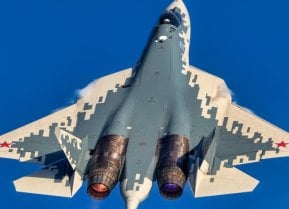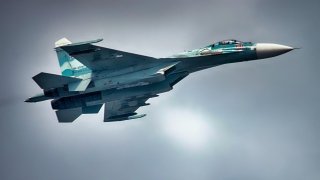Russia's Sukhoi Su-33 is a Poor Excuse for a Carrier-based Fighter
Russia's Sukhoi Su-33 was essentially developed as a carrier variant to serve on the Admiral Kuznetsov, and it is far more than just an upgraded Su-27 Flanker fighter jet.
In December 2016, a Sukhoi Su-33 (NATO reporting name "Flanker-D") jet crashed in the Mediterranean while attempting to land on the Russian Navy's flagship (and problem-plagued) aircraft carrier Admiral Kuznetsov. The aircraft had completed a combat mission over Syria when it was running to the carrier and "overran" the runway.
Mishaps during a carrier landing aren't exactly uncommon, and it certainly takes a great deal of skill and training to accomplish, the incident was just another blemish for both the carrier and the aircraft.
The Sukhoi Su-33 is an all-weather carrier-based twin-engine air superiority fighter designed by Sukhoi and manufactured by the Komsomolsk-on-Amur Aircraft Production Association. It was derived from the Su-27 and initially known as the Su-27K.
Sukhoi Su-33 - The Naval "Flanker"
The Su-33 was essentially developed as a carrier variant to serve on the Admiral Kuznetsov, and it is far more than just an upgraded Su-27. The Su-33 has roughly 8 percent greater wing area than the Su-27 during a routine flight. To accommodate the relatively short runway distances associated with aircraft carriers. The Su-33 also sports a pair of canards on the fuselage to the cockpit’s rear.
As Alex Betley of Tufts University noted, "Despite its similar appearances to the Su-27, the Su-33 Flanker-D has many practical differences including a reinforced undercarriage, more technical landing gear, wing canards, folding wings, a larger wing area, and slightly more powerful AL-31F3 engines. Features such as the landing gear, folding wings, larger wing area, and engine are specifically designed for tighter accommodations and short runways on aircraft carriers. One additional difference is that the Su-33 includes two more hardpoints than the Su-27, bringing the total to twelve."
The weapons control system is reported to be similar to that of the baseline "Flanker-B," which essentially restricted it to an air defense mission.
In terms of armaments, the Sukhoi Su-33 is equipped with a 30-millimeter Gsh-30-1 cannon, while it can carry a wide range of ordnance on its external hardpoints, including R-27R1(ER1), R-27T1(ET1) and R-73E air-to-air missiles, S-8KOM, S-8OM, S-8BM S-13T, S-13OF and S-25-OFM-PU unguided missiles, Kh-25MP, Kh-31 and Kh-41 guided missiles, RBK-500 cluster bombs and electronic countermeasure pods.
Service History
The aircraft began series production in the early 1990s, and in 1993 the first batch of four Su-33s entered service. Yet to date, fewer than two dozen have been produced.
The aircraft was first employed in combat in November 2016 when it was used to strike ISIS and Al-Nusra terrorist facilities in Syria's Idlib and Homs provinces with 500 kg precision bombs.
However, it was just weeks later that one of the Su-33s from Russia's carrier crashed into the Mediterranean Sea after the arrestor cable broke during the aircraft's second landing attempt. The pilot managed to eject and was subsequently rescued.
That was actually the third Su-33 to suffer a catastrophic accident. In July 2001, a Russian Navy Su-33 crashed during an air show and its pilot, Major General Timur Apakidze was killed. Just four years later, another Su-33 was lost in the Northern Atlantic after its arresting cable broke during a landing on the Admiral Kuznetsov. That pilot also ejected and was rescued. The Russian Navy initially planned to destroy the aircraft with depth charges, but it was determined the Su-33 wasn't carrying anything sensitive.
No Foreign Buyers for Su-33
Due to its high cost, and very specific capabilities as a carrier-based fighter, the Kremlin sought to entice foreign buyers. However, attempts to sell the aircraft to China and India – which each operate a former Soviet-era carrier – fell through.
The deal with China hit a snag after Moscow accused Beijing of producing the Shenyang J-15, which is essentially a Su-33 clone fitted with indigenous electronics. Russia claims that China violated intellectual property agreements by creating its own version of the Su-33.
There aren't likely many other interested parties, and even Moscow has limited confidence in the Su-33 as there are plans to retire the air superiority fighter when it reaches its end of service life.
In 2009, the Russian Navy ordered the MiG-29K as a replacement, as it is a more compact aircraft and better suited to service from a carrier. The MiG-29K is also outfitted with electronic countermeasures and a more sophisticated radar system that can aid in ground-strike missions – while it has been reported to be a more affordable fight. Thus, it is likely that the MiGs and not the Su-33 will make up the airwing when the Admiral Kuznetsov ever returns to service – if that actually happens, of course.
As the Admiral Kuznetsov has been undergoing a refit for several years, it even remains unclear where the remaining Su-33s are actually based or if the aircraft have simply been quietly retired from service.
Author Experience and Expertise
Peter Suciu is a Michigan-based writer. He has contributed to more than four dozen magazines, newspapers, and websites with over 3,200 published pieces over a twenty-year career in journalism. He regularly writes about military hardware, firearms history, cybersecurity, politics, and international affairs. Peter is also a Contributing Writer for Forbes and Clearance Jobs. You can follow him on Twitter: @PeterSuciu.
Image Credit: Creative Commons.


